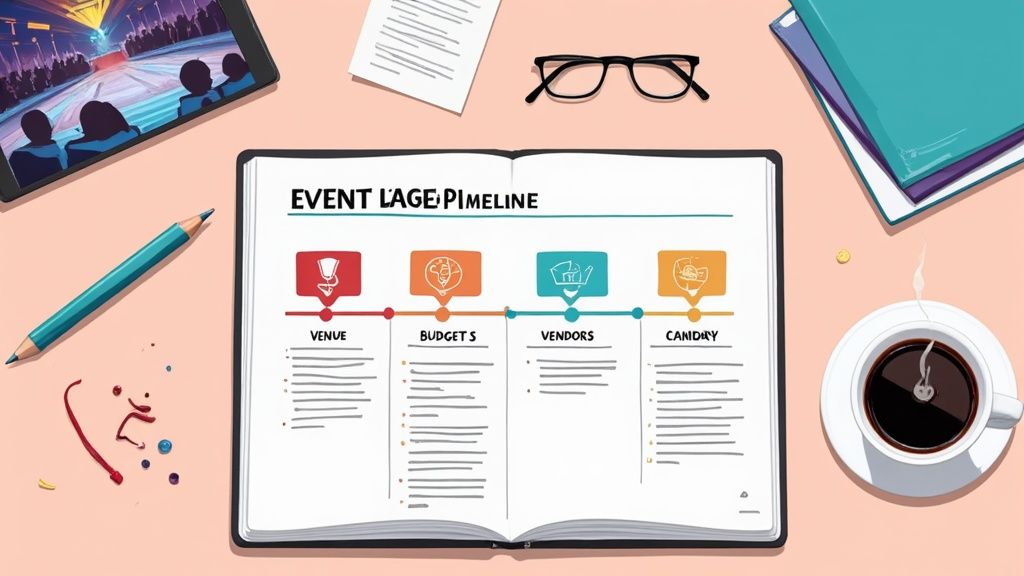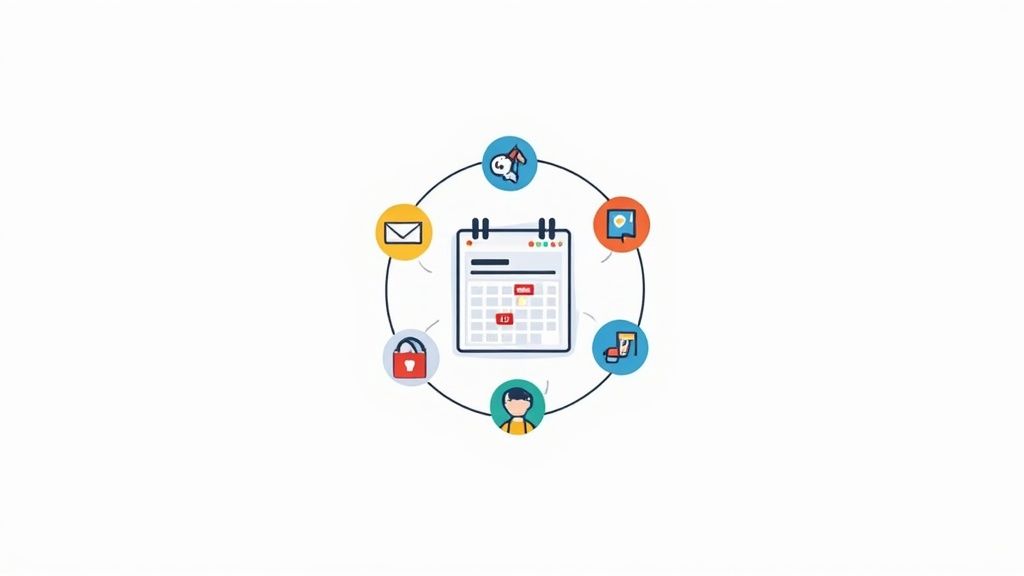An event planning timeline template isn't just a fancy to-do list. It’s a complete, reusable framework that maps out every single task, deadline, and milestone, from the initial "what if?" idea all the way to the post-event debrief. It’s the master plan that ensures nothing gets missed, whether you're orchestrating a massive corporate conference or a simple webinar.
Why a Solid Timeline Is Your Event's Foundation
Let’s be real for a second - event planning is organized chaos. You’re juggling vendors, stakeholder expectations, and a dozen marketing campaigns all at once. It’s ridiculously easy for a critical task to fall through the cracks. This is where a strategic timeline becomes more than just a way to "stay organized." It's the central nervous system for your entire event.
Seasoned planners don't just use timelines as a checklist; they use them as a dynamic communication hub. It’s the one document that keeps your marketing team, A/V crew, and catering vendor all on the same page, preventing those costly mistakes and frantic last-minute scrambles. Think of it as your single source of truth.
The Lifecycle of Event Planning
Every event, big or small, follows a surprisingly predictable lifecycle. Getting a handle on these phases is the key to building a timeline template that actually works. When you break the journey down into manageable chunks, you can allocate your time and budget much more effectively and see potential roadblocks from a mile away.
This kind of structured approach is becoming non-negotiable. The global events market is on track to hit a staggering $2.5 trillion by 2035. On top of that, 66% of event professionals are planning to schedule more events in the coming year. This boom means planners are relying heavily on tools to manage the growing complexity. In fact, 79% already use Event Management Systems - which are built around detailed timelines - to coordinate every last detail. If you want to dive deeper into the numbers, you can explore the latest event industry statistics.
A well-built timeline is more than a schedule; it's a powerful risk management asset. It helps you identify potential bottlenecks - like a tight deadline for venue selection or a delay in speaker confirmations - before they become crises.
A Glimpse into the Core Phases
To give you a bird's-eye view, let's look at how a typical event planning journey unfolds. This table breaks down the core phases, offering a high-level snapshot of key activities and when they generally happen.
The Event Planning Lifecycle At A Glance
This table maps out the fundamental stages of event planning, from initial strategy to post-event wrap-up. Use it as a guide to structure your own timeline.
| Event Phase | Typical Timeframe (Pre-Event) | Core Activities & Focus |
|---|---|---|
| Strategy & Foundation | 6-12+ Months | Defining goals, setting the budget, securing the venue, and building the core team. |
| Planning & Logistics | 3-6 Months | Booking vendors (catering, A/V), launching initial marketing, and finalizing speakers. |
| Promotion & Engagement | 1-3 Months | Ramping up marketing, sending invitations, managing registrations, and coordinating details. |
| Final Preparations | 2-4 Weeks | Finalizing guest lists, creating seating charts, conducting rehearsals, and final vendor checks. |
| Execution & Wrap-Up | Event Day & Post-Event | Managing on-site logistics, executing the event, and conducting post-event analysis. |
By building your event planning timeline template around these fundamental stages, you create an adaptable and scalable tool that brings clarity to even the most complex projects. It's how you ensure every person involved knows exactly what to do and when, turning a potentially stressful process into a well-orchestrated success.
Alright, let's get practical. Enough talk about theory - it's time to roll up our sleeves and build a flexible event planning timeline template you can use for pretty much any event that comes your way. A solid timeline is more than just a to-do list; it’s your strategic roadmap. Instead of just throwing random tasks on a page, we need to start with the big, unchangeable anchors of your project.
First things first: define the event's core purpose. Are you launching a product? Trying to generate new leads? Or maybe you're celebrating a huge company milestone? Once you know the why, you can lock in a date and hammer out a realistic, line-item budget. These three pieces - your goals, the date, and your budget - are the bedrock. Everything else builds on them. Without them, you're just flying blind.
Working Backward from Your Event Date
The secret sauce for building a bulletproof timeline is a classic industry technique: working backward from the event date. It sounds simple, but this method is a game-changer. It forces you to think chronologically and ensures you leave enough runway for every critical phase. It turns what feels like a massive, overwhelming project into a series of smaller, more manageable steps.
Let's imagine a real-world scenario. You're tasked with planning a 200-person corporate conference that's six months away. That event date is your finish line. Every single task, from the huge milestones down to the tiniest details, gets a deadline based on how long it needs to be completed before that final day.
The whole process boils down to defining your event phases, setting key milestones, and then putting dates and names next to each task. This infographic breaks down the flow perfectly.
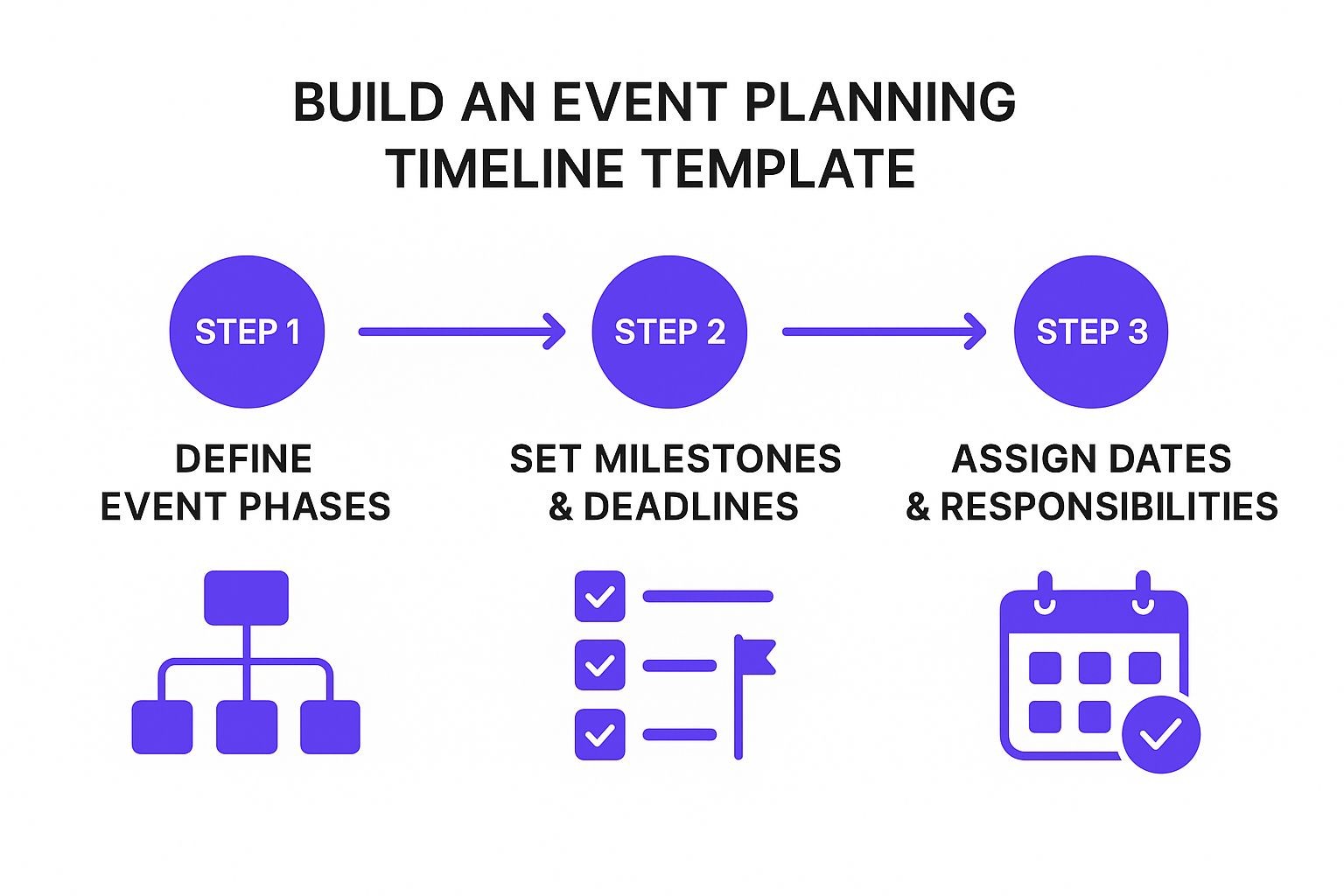
When you see it laid out like this, you realize that building a timeline isn't some chaotic brainstorming session. It's a logical progression. Each step naturally flows from the one before it, giving you a structured, repeatable framework you can use again and again.
Breaking Down Major Milestones
Once you have your framework, you can start plugging in the major milestones. For our corporate conference example, here’s a rough sketch of what that could look like:
- 6 Months Out: Finalize the budget, lock in the venue, and book your keynote speaker.
- 4-5 Months Out: Kick off vendor negotiations (think catering, A/V), get the event website live, and open up early-bird registration.
- 2-3 Months Out: Finalize the complete speaker lineup, send out the official invitations, and start pushing your marketing campaigns hard.
- 1 Month Out: Close registration, give the caterer your final headcount, and confirm all logistics with every single vendor.
This gives you a great high-level view, but the magic really happens when you break these milestones down into smaller, actionable sub-tasks. "Secure the venue," for instance, isn't just one item you check off a list. It's a whole process: researching locations, doing site visits, negotiating contracts, and finally, paying the deposit. Each of those little steps needs its own deadline and someone responsible for it.
Pro Tip: Always, always build buffer time into your timeline. Just assume something will go wrong - a vendor will ghost you for a week, a key shipment will get delayed. A 10-15% buffer on major deadlines can be the difference between a smooth-sailing event and a last-minute stress-fueled panic.
Assigning ownership is just as critical. Who’s in charge of researching venues? Who's running the marketing campaign? A timeline without clear accountability is nothing more than a wish list. By putting a name next to every task, you create a culture of responsibility and make sure nothing falls through the cracks. This detailed, person-by-person approach is what separates a good event planning timeline template from a great one.
How to Adapt Your Timeline for Any Event
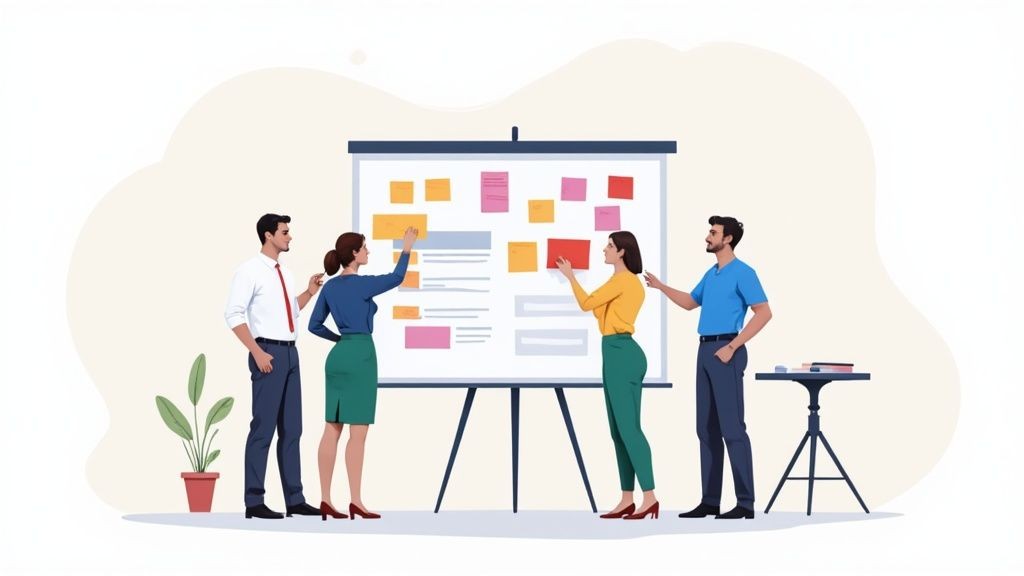
Think of your universal event planning timeline as your base recipe - it’s the solid foundation you start with, not the finished meal. The timeline for a sprawling corporate conference will look completely different from one for an intimate community fundraiser. The real magic happens when you adapt that foundational framework to fit the unique personality of each event.
The core structure is almost always the same: you start with the event date and work your way backward. What changes - often dramatically - are the specific tasks, the lead times you need, and how all those little pieces depend on each other. Customization isn't just a nice-to-have; it's absolutely essential to get things right.
Tailoring Timelines for Large-Scale Events
When you're dealing with big events like trade shows or multi-day conferences, your timeline needs a much, much longer runway. The sheer complexity and number of moving parts mean you have to lock down the big-ticket items early. Imagine a trade show with custom-built booths and exhibitors flying in from all over the world.
For a trade show, you'll need to make some key adjustments:
- Booth Fabrication & Design: This is not a last-minute job. You absolutely have to set deadlines for design approvals and construction at least 6-9 months out.
- Freight & Logistics: Getting booths and materials shipped, especially internationally, means booking freight services 3-4 months in advance, minimum.
- Sponsorship & Exhibitor Management: The sales cycle for locking in sponsors and exhibitors often kicks off a full year before the event doors even open.
A corporate conference, on the other hand, will have different priorities. You'll be focused on securing a massive block of hotel rooms or nailing down a complex agenda with tons of breakout sessions. Those things typically need to be finalized 8-10 months beforehand.
An adaptable event planning timeline is more critical than ever. New data shows that 41% of event professionals are planning to host more events this year, and we're seeing a 16% jump in micro-events. This trend toward more frequent and varied events makes a one-size-fits-all timeline totally obsolete. You can dig into how event frequency is shaping planning strategies on swoogo.events.
Adapting for Smaller, Focused Events
While big events are all about long lead times, smaller gatherings like micro-events or local fundraisers require a different kind of focus. The timeline is often shorter and more compressed, but the pressure to nail the details and the guest experience is even higher.
For a micro-event designed to be an exclusive, high-touch experience, your timeline is less about massive logistics and more about careful curation.
Think about the unique tasks you'd add for a micro-event:
- Personalized Invitations: Forget the mass email blast. You'll need to block out time for designing, printing, and mailing bespoke physical invitations.
- Guest Curation: The guest list is everything. Your timeline should have a dedicated phase for identifying and personally reaching out to your ideal attendees.
- Unique Vendor Sourcing: Finding that perfect private chef or a niche entertainer isn't something you can do overnight. This should be a top priority early in the planning process.
A community fundraiser would add yet another layer. You'd need to build in deadlines for securing auction items, wrangling volunteer schedules, and launching donation campaigns. The skeleton of your master template is still there, but it's these event-specific tasks that truly bring the plan to life and let you manage a packed calendar without ever dropping the ball.
Integrating Budgets and Vendors Into Your Timeline
A timeline without financial checkpoints and vendor management tasks is really just a wish list. To turn your schedule into a real-world project management tool, you have to weave in the money and the partners. This is what keeps you from blowing your budget or scrambling for a caterer at the last minute.
It all starts with treating your budget not as some separate spreadsheet, but as a living part of your schedule. Your event planning timeline template needs specific entries for critical financial actions. So, instead of a vague task like "Marketing," you’d have concrete milestones like "Secure Tier 1 Sponsorships by Q2" or "Hit 50% Ticket Sales by August 1st." It’s about accountability.
Managing Finances and Vendors in Tandem
This financial integration is more important now than ever. Event planners are in a tough spot where costs are climbing faster than budgets. We're seeing industry data showing that while event costs are set to jump by 12%, budgets are only inching up by about 11%. That razor-thin margin means every single dollar needs to be tracked right inside your timeline. You can get a closer look at the 2025 event planning outlook on encoreglobal.com to see the full picture.
To handle this pressure, smart planners are building cost-saving strategies right into their schedules. For example, your timeline might include a dedicated phase for researching and locking in venues in more affordable second-tier cities.
A timeline isn't just for tasks; it’s for accountability. By mapping out vendor payment due dates, you eliminate the risk of late fees or, even worse, a canceled contract.
Your timeline should also be your command center for all things vendors. This goes way beyond just a simple "Book a Photographer." A truly useful timeline breaks this down into smaller, actionable steps with hard deadlines.
- Initial Outreach: Shortlist 3-5 potential photographers and send out inquiry emails. (Deadline: 6 months out)
- Contract Review: Get the preferred vendor’s contract over to your legal team for a once-over. (Deadline: 5.5 months out)
- Deposit Payment: Schedule and confirm that initial deposit payment is sent and received. (Deadline: 5 months out)
- Pre-Event Huddle: Jump on a final check-in call to confirm the shot list and arrival times. (Deadline: 1 week out)
This level of detail makes sure every partner is perfectly synced with your event’s goals and schedule. And for anything that requires input from attendees, like meal choices, having a simple sign-up process is a lifesaver. You can learn how to create an RSVP link to pull that data in smoothly and feed it right back into your planning.
When you connect your budget, vendors, and timeline, you're not just making a schedule - you're building a resilient plan that keeps your event financially sound and logistically seamless.
Pro Tips for a Dynamic and Resilient Timeline
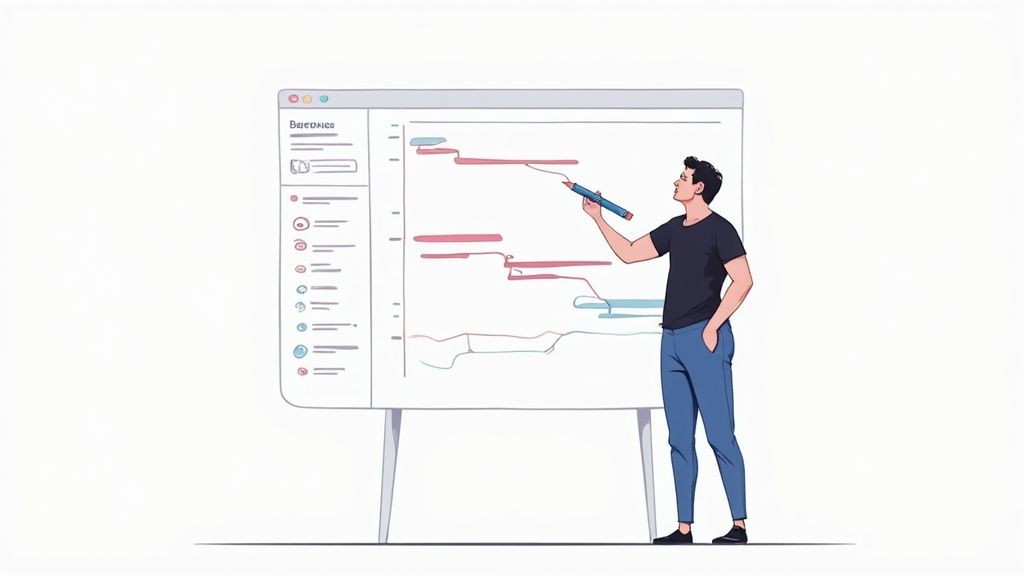
Look, an event timeline isn't something you create once and then stick in a drawer. Its real value comes from being a living document - a dynamic game plan that flexes and adapts as you go.
This is where your timeline goes from being a simple checklist to your command center, helping you navigate any surprises that pop up along the way.
The absolute key to keeping your timeline active and useful is communication. Don't let that perfect plan you built collect digital dust. Get into the habit of running weekly timeline review meetings with your core team.
These aren't long, boring status updates. They're quick, focused huddles for accountability. Go through the upcoming deadlines line by line, confirm what's done, and - most importantly - spot any roadblocks before they turn into full-blown crises.
Modern Tools to Keep Things Moving
Let’s be honest, modern event planning runs on efficiency. Instead of manually chasing down every single update, you can lean on digital tools to do the heavy lifting for you. This is exactly what event management software was built for.
With the right platform, you can:
- Automate Reminders: Set up automatic pings for your team and vendors when deadlines are getting close. No more nagging.
- Track Progress Visually: Use shared timelines or project boards to see exactly what’s complete, what’s in progress, and what’s falling behind.
- Keep Communication in One Place: Attach all discussions and files directly to their specific tasks. This instantly kills the chaos of scattered emails and lost info.
This approach doesn't just save a ton of time; it also makes sure everyone is working from the same, most current version of the plan.
On top of that, many of these tools can automate communications with your attendees. You can learn how to structure and send effective email event reminders to keep your audience in the loop without adding more to your plate.
Choosing the Right Event Planning Software
With so many options out there, picking the right software can feel overwhelming. The best tool for you really depends on your specific needs - from the size of your team to the complexity of your events. Here’s a quick look at some popular choices to help you get started.
Comparison of Popular Event Planning Tools
Here's a look at leading event management software, comparing key features relevant to timeline management, collaboration, and budgeting to help you choose the best fit.
| Tool | Best For | Key Timeline Features | Collaboration Level |
|---|---|---|---|
| Trello | Visual, Kanban-style project management for smaller teams. | Card-based tasks, due dates, checklists, visual progress boards. | Good |
| Asana | Detailed task management and complex project workflows. | Gantt charts, task dependencies, automated rules, workload management. | Excellent |
| Monday.com | Highly customizable workflows for various event types. | Multiple views (Kanban, timeline, calendar), automations, dashboards. | Excellent |
| Cvent | All-in-one platform for large-scale corporate events. | Integrated project plans, budgeting tools, registration, and reporting. | Very Good |
Ultimately, the goal is to find a tool that makes your life easier, not more complicated. Most offer free trials, so don't be afraid to test a few out to see which one feels right for you and your team.
A resilient timeline anticipates problems. It doesn't just list what needs to go right; it includes a solid plan for what could go wrong. That’s the real difference between a professional and an amateur.
Build in a Backup Plan (Or Two)
The final piece of a truly bulletproof timeline is planning for the unexpected. Because things will happen. A keynote speaker gets sick, a critical shipment is delayed, or a sudden storm threatens your outdoor venue.
A resilient timeline has a Plan B - and sometimes even a Plan C - built right in.
For every major milestone or dependency, ask yourself, "What's the worst that could happen here?" Then, build a contingency task right into your timeline.
- Main Task: Confirm Keynote Speaker
- Contingency: Identify and pre-vet two backup speakers.
- Main Task: Set up outdoor tents.
- Contingency: Place a hold on an indoor backup venue.
By embedding these backup plans directly into your event planning timeline template, you’re not just hoping for the best; you're prepared for reality. When a problem pops up, your team doesn’t panic. They just switch to the contingency, keeping the event moving forward.
Common Questions About Event Planning Timelines
Even with a killer timeline template, questions always come up in the trenches. I get it. Let’s tackle some of the most common ones I hear from planners to give you quick answers and keep you on track.
What’s The Ideal Lead Time For An Event?
The classic, and most honest, planner answer is: it depends. There’s just no single "right" amount of time.
I’ve seen massive international conferences need 18-24 months just to lock in A-list speakers and prime venues. On the flip side, I've also helped pull off successful internal company workshops and local fundraisers in just 3-4 months.
Your best bet is to always work backward from the event date. Think about these key factors:
- Venue & Vendor Availability: The best spots can get booked more than a year out. Don't wait.
- Attendee Travel: Are people flying in? Give them at least a 6-month heads-up so they can sort out flights and hotels without breaking the bank.
- Marketing & Promotion: A good marketing push needs a few months to gain traction and really start driving those registrations.
A common pitfall I see is underestimating how long it takes to lock down sponsorships and get contracts signed. For any major partnerships, you need to be starting those conversations at least 6-8 months before your event.
How Detailed Should My Timeline Be?
Your timeline needs enough detail to kill any confusion, but not so much that your team gets lost in the weeds. A great rule of thumb is to break down your big milestones into smaller, concrete tasks.
For example, a task like "Secure Catering" is way too vague. It leaves too much room for error.
Instead, break it down like this:
- Research and create a shortlist of 5 potential caterers.
- Schedule tasting sessions with your top 3 picks.
- Negotiate the menu and finalize the contract.
- Submit the final headcount to the caterer.
Each of those smaller steps should have its own deadline and a clear owner. This way, everyone knows exactly what they’re on the hook for and when it’s due. No more guessing games.
What If We Fall Behind Schedule?
Look, falling behind is going to happen. It's almost a rite of passage in event planning. What matters is how you react.
The second you spot a delay, bring it up in your weekly team meeting. Figure out the root cause. Is it a lack of resources? A vendor dropping the ball? Did we just set an unrealistic deadline to begin with?
Once you know the why, you can pivot. Maybe you need to reassign a few people, have a tough conversation with stakeholders about a new timeline, or pull the trigger on one of those contingency plans you wisely built into your schedule.
The goal isn't to create a perfect plan that never changes. It's to have a living document that helps you get back on track fast. After all, a solid timeline is a tool, and a huge part of its job is making sure you know how to increase event attendance by keeping your promotional schedule humming along.
Ready to streamline your event promotions and make sure your guests never miss a date? Add to Calendar PRO offers powerful, easy-to-use "Add to Calendar" buttons that integrate seamlessly with your event pages, emails, and marketing campaigns. Start your free trial today and simplify your event marketing.
